Europe, France, Brittany [Map]
Brittany is in France.
On 15 Sep 1146 Alan "Black" Penthièvre 1st Earl Richmond (age 46) died at Brittany [Map]. His son Conan "The Young" Penthièvre IV Duke Brittany (age 8) succeeded 2nd Earl Richmond.
In 1471 King Henry VII of England and Ireland (age 13) fled to Brittany [Map].
In 1483 Edward Woodville Lord Scales (age 27) travelled to Brittany [Map].
On 26 Apr 1483 Edward Woodville Lord Scales (age 27) put to sea with around twenty ships taking a part of the Royal treasure with him eventually arriving in Brittany [Map].
Around Nov 1483 Thomas Grey 1st Marquess Dorset (age 28) and Eleanor Bohun Countess Ormonde escaped to Henry VII in Brittany [Map]. Walter Hungerford (age 19), Giles Daubeney 1st Baron Daubeney (age 32) and Edward Courtenay 1st Earl Devon (age 24) took part. The rebellion was suppressed by Richard Guildford (age 33) and Robert Willoughby 1st Baron Willoughby 9th Baron Latimer (age 31).





In 1489 Parliament granted King Henry VII of England and Ireland (age 31) £10,000 taxes to pay for his support of Anne of Brittany Queen Consort France 1477-1514's claim to the throne of Brittany [Map]. The North rebelled claiming to have already paid through local taxes.
In 1491 Thomas Wriothesley (age 3) accompanied King Henry VII of England and Ireland (age 33) to Brittany [Map].

In 1491 Henry Willoughby (age 40) fought at Brittany [Map].
Europe, France, Brittany, Blain
On 24 May 843 the Battle of Blain aka Messac was a battle between Brittany and the County of Nantes over control of Nantes which, at that time, was controlled by the Frankish Kingdom. The Franks were defeated.
Lambert Guideschi II Count Nantes commanded the Breton army.
Renaud Count of Herbauges, Poitiers and Nantes, who commanded the army of Nantes, was killed the following day.
Europe, France, Brittany, Brest
Wriothesley's Chronicle 1510-1519. 10 Aug 1512. This yeare the Regent of England, a shippe, and a carike of France, were burnt in Bristowe haveng, and Sir Thomas Knyvett (age 27) in her with all his men.
Note g. Note. This engagement, one of the most striking recorded in the annals of the English nayy, was fought off Brest Harbour on the 10th August, 1512, in which the Regent, a first-class English vessel, commanded by Sir Thomas Knyvett (age 27), Master of the Horse, and the French vessel Cordeliere, commanded by Primanget, called by the English chroniclers Sir Piers Morgan, were blown up with the loss of all their men. Hall's Chronicle, pp. 634-6. A letter of Wolsey, describing the loss of the Regent, may be seen in MS. Cotton. Vitcl. B. ii. p. 180.
On 10 Aug 1512 Edward Howard (age 36) commanded at Brest during the Battle of Saint Mathieu.
Thomas Knyvet (age 27) was killed in the fight between The Regent and La Reine
Pepy's Diary. 02 Jan 1667. Up, I, and walked to White Hall to attend the Duke of York (age 33), as usual. My wife up, and with Mrs. Pen (age 16) to walk in the fields to frost-bite themselves. I find the Court full of great apprehensions of the French, who have certainly shipped landsmen, great numbers, at Brest; and most of our people here guess his design for Ireland. We have orders to send all the ships we can possible to the Downes. God have mercy on us! for we can send forth no ships without men, nor will men go without money, every day bringing us news of new mutinies among the seamen; so that our condition is like to be very miserable.
Evelyn's Diary. 13 Jul 1694. Lord Berkeley (age 31) burnt Dieppe and Havre de Grace with bombs, in revenge for the defeat at Brest. This manner of destructive war was begun by the French, is exceedingly ruinous, especially falling on the poorer people, and does not seem to tend to make a more speedy end of the war; but rather to exasperate and incite to revenge. Many executed at London for clipping money, now done to that intolerable extent, that there was hardly any money that was worth above half the nominal icon.
Europe, France, Brittany, Carnac
Archaeologia Volume 22 Section XIV. Account of a Visit to the Monument usually considered as Druidical, at Carnac in Brittany, made in the month of September 1825, by Alexander Logan, Esq.: Communicated by James Logan, Esq. F.S.A. Edinb. in a Letter to the Right Honourable the Earl of Aberdeen, K.T. President. Read 14th June 1827.
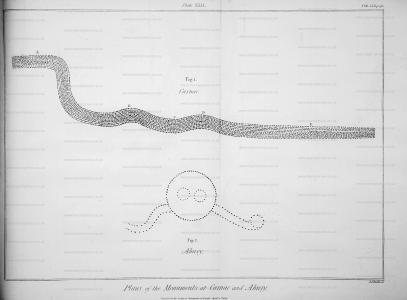
Europe, France, Brittany, Carnac, Kerlescan Stone Rows [Map]
Kerlescan Stone Rows is also in Prehistoric Brittany Stones.
Archaeologia Volume 25 Section XII. Kerlescan Stone Rows [Map].
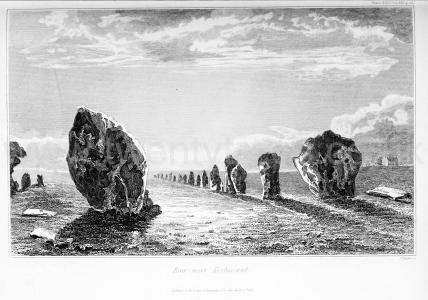
Europe, France, Brittany, Carnac, Ménec Stone Rows [Map]
Ménec Stone Rows is also in Prehistoric Brittany Stones.
Archaeologia Volume 25 Section XII. Ménec Stone Rows [Map].
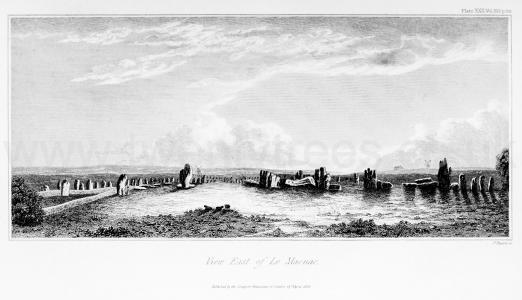
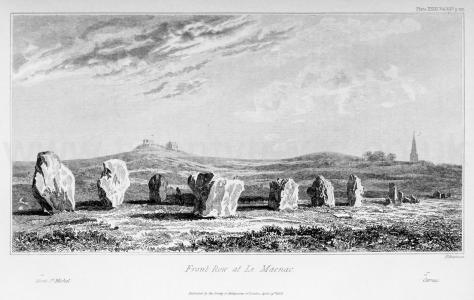
Europe, France, Brittany, Dinan
Europe, France, Brittany, Dinan, Motte Broons
Around 1320 Bertrand Geusclin was born at Motte Broons.
Europe, France, Brittany, Dinard
On 14 Nov 1900 William Montagu 9th Duke Manchester (age 23) and Helena Zimmerman (age 22) were married at St Marylebone Church. They had met at a costume ball at a Brittany coast resort in Dinard in Brittany. They had two sons and two daughters. He the son of George Victor Drogo Montagu 8th Duke Manchester and Consuelo Yznaga Duchess Manchester (age 47).
Europe, France, Brittany, Finistère
Europe, France, Brittany, Finistère, Camaret
On 13 Jan 1403 Joanna of Navarre Queen Consort England (age 33) with her two daughters Marguerite Montfort Viscountess Rohan (age 11) and Blanche Montfort Countess Armagnac (age 6) departed from Camaret to travel to England intending to land at Southampton. A storm caused them to land at Falmouth, Cornwall from where they travelled to Winchester.
Europe, France, Brittany, Finistère, Plouigneau
On 05 Sep 1095 Main D'Aubigny (age 40) died at Plouigneau.
On 13 Aug 1417 Bryan Stapleton (age 33) died at Plouigneau.
Europe, France, Brittany, Guerrand [Map]
On 02 Oct 1386 John Montfort V Duke Brittany (age 47) and Joanna of Navarre Queen Consort England (age 16) were married at Saillé [Map]. She by marriage Duchess Brittany 1221 Dreux, Countess Richmond. His third marriage, her first. The marriage proceeded when her father Charles "Bad" II King Navarre (age 53) agreed to give his daughter 120,000 gold francs and to pay 6,000 francs owed to John, duke of Brittany (age 47), for the rent of certain lands. He, John, gave her the cities of Nantes [Map] and Guerrand [Map]. The difference in their ages was 31 years. She the daughter of Charles "Bad" II King Navarre (age 53) and Joan Valois Queen Consort Navarre. They were second cousin twice removed. He a great x 2 grandson of King Henry III of England. She a great x 4 granddaughter of King Henry III of England. 
Europe, France, Brittany, Guillac
On 26 Mar 1351 the Combat of the Thirty was an arranged fight between selected combatants from both sides of the conflict, fought at at Guillac, a site midway between the Breton castles of Josselin and Ploërmel among 30 champions, knights, and squires on each side.
Robert Knollys (age 26) took part.
Hugh Calverley (age 27) fought, was captured and ransomed.
Europe, France, Brittany, Hennebont
In 1295 John Montfort IV Duke Brittany was born to Arthur Capet Duke Brittany (age 33) and Yolande Capet Duchess Brittany (age 34) at Hennebont. He a great grandson of King Henry III of England.
On 16 Sep 1345 John Montfort IV Duke Brittany (age 50) died at Hennebont. His son John Montfort V Duke Brittany (age 6) succeeded V Duke Brittany 1221 Dreux. Mary Plantagenet Duchess Brittany by marriage Duchess Brittany 1221 Dreux.

Europe, France, Brittany, Ille et Vilaine
Europe, France, Brittany, Ille et Vilaine, Grand Fougeray
On 22 Aug 851 Lambert Guideschi II Count Nantes fought at Grand Fougeray during the Battle of Jengland.
Europe, France, Brittany, Ille et Vilaine, Redon
On 22 Nov 845 Lambert Guideschi II Count Nantes fought at Redon during the Battle of Ballon.
Europe, France, Brittany, Morbihan
Europe, France, Brittany, Morbihan, Auray
On 29 Sep 1364 Battle of Auray decided the Breton Succession in favour of John Montfort V Duke Brittany (age 25). The Breton and English army was commanded by John Chandos (age 44) and included William Latimer 4th Baron Latimer of Corby (age 34), Miles Stapleton (age 44) and Hugh Calverley (age 40). Charles "Saint" Chatillon Duke Brittany (age 45) was killed. Bertrand Geusclin (age 44) surrendered. 

Europe, France, Brittany, Morbihan, Gavrinis
Europe, France, Brittany, Morbihan, Gavrinis Burial Mound [Map]
Gavrinis Burial Mound is also in Prehistoric Brittany Burials.
Archaeologia Volume 32 Appendix. Further Notice of the Monument at Gaur' Innis [Map] in Britanny.
29th April, 1847 - William Bromet, Esq. M.D. F.S.A. in another Letter to the Director, communicated a further explanation of the Monument at Gaur' Innis in Britanny — together with some rubbings from those of its sculptured stones which he considered the most interesting. A remarkable peculiarity in this Monument consists in the interior faces of several of its component stones being engraved with concentric curves resembling eels or serpents: and others with those instruments called celts, or small ovals pointed at one end, but so placed as to give an appearance of their being hieroglyphic characters. There are only two other instances of the kind on record, viz. one formerly near Gavr' Innis called the "Pierres Plates now destroyed, and the one at New Grange, in Ireland. Another distinctive feature is a sort of staple made in the stone at about three feet from the ground, by three holes communicating with each other at the back, and indicating much friction by the internal smoothness, as if by the action of ropes passed through.
Europe, France, Brittany, Morbihan, Locmariaquer
Archaeologia Volume 25 Section XIII. Remarks on certain Celtic Monuments at Locmariaker, in Britany; in a Letter from the Rev. John Bathurst Deane (age 36), M.A., F.S.A., to Henry Ellis, Esq. F.R.S., Secretary. Read 17th January, 1833.
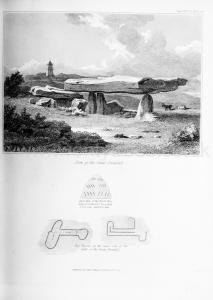
Europe, France, Brittany, Morbihan, Locmariaquer, Mané Lud Burial Mound [Map]
Mané Lud Burial Mound is also in Prehistoric Brittany Burials.
Archaeologia Volume 25 Section XIII. The accompanying plan (Plate XXV.) exhibits within a small area two long tumuli, each containing a Kistvaen; a small tumulus with a Kistvaen of unusual length; two cromlechs, one of them of singular beauty; and two obelisks, each carved out of a single stone, of which one measured upwards of 35 feet in length, the other 63!
1. The tumuli are clearly sepulchral from the evidence of the Kistvaens which they once covered. The two largest are called the mounds of Héleu, and of Cæsar. The small one is nameless, although it contains the longest Kistvaen.
The tumulus of Héleu [Mané Lud Burial Mound [Map]] is 100 feet broad, 300 feet long, and has an elevation of 30 feet. That of Cmsar is of the same elevation and breadth, but 400 feet in length. They are both composed of layers of earth and stones, separate and mixed. The section of Heleu given in the plan shows 26 feet of earth, overlaid by a coating three feet deep of earth and stones, surmounted by a covering of earth one foot in depth.
This tumulus is remarkable for its shape, which is very similar to that of the Temple of Carnac at Le Maenac; a campanular [bell shaped] head being added to the usual straight mound of parallel sides.
In this head is a Kistvaen of considerable dimensions; and particularly interesting, as being partly exposed and partly covered. It affords an example of the manner in which the Kistvaens were overlaid by tumuli. Two tabular stones cover the chamber. One is a parallelogram fifteen feet six inches by fourteen feet; the other, an irregular quadrangular figure with an acute angle pointed towards the entrance of the tomb. Its breadth at the base, where it meets the parallelogram, is fourteen feet nine inches; its breadth from the angle to the base, thirteen feet. The dolmen is supported in the usual manner upon massive props. The whole length of the Kistvaen is twenty-seven feet, the depth of the chamber six feet.
The other long tumulus, which has its Kistvaen in the centre, is ridiculously ascribed to Julius Caesar, whose only work (if it was indeed his) in the neighbourhood of Locmariaker, is a curious square embankment on the sea shore about a mile distant, round a marine marsh, appearing to have been made for the purpose of a dry dock. General de Penhouet, who discovered it, thinks it Roman; and it has every appearance of being so. The tumulus ef Caesar has been much disturbed, and its Kistvaen destroyed.
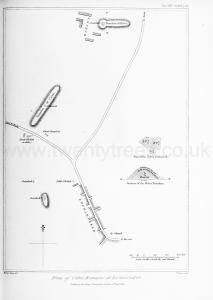
Europe, France, Brittany, Morbihan, Locmariaquer, Menhir Er Grah [Map]
Menhir Er Grah is also in Prehistoric Brittany Stones.
Archaeologia Volume 25 Section XIII. 3. The third species of monument remaining at Locmariaker is the round Obelisk [Menhir Er Grah [Map]]. A beautiful one stood at the head of Caesar's tumulus; and it was sixty-three feet in length and fourteen feet in diameter at the thickest part, which is at about twenty feet from the base. From this point it tapers gradually both ways. Another obelisk, about thirty-five feet in length, lies at the entrance of the village; its tumulus was perhaps removed to make room for a house. Each of these is cut out of a single stone.
These obelisks probably denoted the burial-places of warriors of the first rank: and may have originated in the well-known custom still prevalent in the East, of planting an upright spear at the head of a Chief as he slept upon the ground. It was thus that David found Saul on the hill of Hachilah: "Behold Saul lay sleeping within the trench, and his spear stuck in the ground at his bolster."a This custom was universal in the East. Homer mentions it, and it has been repeatedly observed by travellers in Persia and Hindustan. The spear at the head, thus planted, always denotes a warrior of the highest rank.
Some mighty Celtic chief may in like manner be supposed to be sleeping at Locmariaker, under the tumulus of Caesar, "with his spear stuck in the ground at his bolster: "only the sleep being that of death, the spear is of a material of corresponding duration; it is an obelisk of stone cut out of a single block.
The evangelizers of Britany, for they probably were the destroyers, suffered not the warrior's spear to mark his last resting-place. The obelisk was overthrown, as an object of superstitious veneration, and now lies broken in four pieces. The tomb also has been rifled of its sacred deposit; and the whole is but a variety of the continual work of ruin which in every country records the mutability of man, and the vanity of his earthly hopes.
The original weight of this column must have been about 260 tons! and the labour required to remove it from the quarry and to plant it at the head of the tumulus of Caesar may be imagined, by calling to our recollection the power employed by Fontana to place the obelisk of the Vatican in its present site at Rome. The latter column was only fifteen feet longer than the obelisk before us; and, although it weighed only 150 tons, whereas that of Locmariaker weighed 26 0, yet it required the united efforts of eight hundred men and sixty horses, complex machinery, and the expenditure of ^*5000, to remove it for a short distance, and erect it as it now stands! We should also recollect that the erection of the obelisk of Locmariaker was the work of a rude age, ignorant, probably, of the mechanical powers, and mainly effected by human strength.
Note a. 1 Samuel, xxvi. 7.
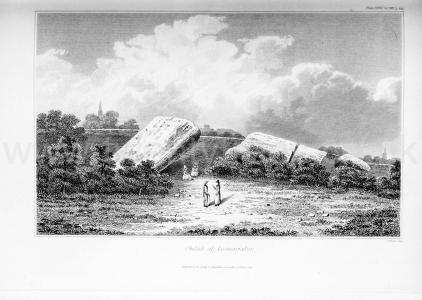
Archaeologia Volume 32 Appendix. Cromlech and Obelisk at Locmariaker in Britanny.
11th March, 1847. William Bromet, Esq. M.D. F.S.A. in a Letter to the Director, remarks, that having called attention to the somewhat exaggerated views of a Cromlech and Obelisk [Menhir Er Grah [Map]] in Britanny, presented some years ago to the Society by the Rev. J. Bathurst Deane, he now exhibits another Drawing of this Cromlech or Dolmen, as it is called in its neighbourhood; and also a Drawing of the Interior of the Cavern under the tumulus Gaur' Innis. The upper or table stone of the Cromlech, according to Dr. Bromet's own measurement, is twenty-one feet long, twelve broad, and four deep; it is supported by three vertical stones which are between five and six feet above ground; and there is another and shorter vertical stone, which, although not a supporter, was evidently erected for the purpose of its becoming so, should either of the three other uprights fail — a provision observed in similar Antiquities in Cornwall. The Obelisk, or Menhir, has long been in a fallen and fractured state; it consists of four pieces, altogether more than seventy feet long, and at its largest end fourteen feet broad, with an estimated weight of two hundred and fifty tons.
Europe, France, Brittany, Morbihan, Locmariaquer, Table des Marchands [Map]
Table des Marchands is also in Prehistoric Brittany Burials.
Archaeologia Volume 25 Section XIII. 2. But near it is the most beautiful cromlech [Table des Marchands [Map]] which I have ever seen; and I may add, the most interesting. The table stone, which is eighteen feet long, twelve feet wide, and four feet thick, is supported upon three props, on one of which it rests upon a very small point. It has the approach usually attached to the Kistvaens of Britany, consisting of an avenue of contiguous stones placed edge to edge, and covered in by three slabs of stones. The highest part of the table is about nine feet from the ground, the height of the approach is about four feet.
Although this monument is, strictly speaking, a cromlech, yet the ashes and a flint knife which have been discovered under it, together with the avenue of approach, prove it to have been sepulchral.
The beauty of this cromlech would of itself be sufficiently interesting; but, in addition to its elegance of figure, it presented to our admiration the only hieroglyphical characters which it was our fortune to see inscribed on a Celtic monument; unless I except a rude unmeaning or rather unintelligible scrawl upon one of the supporting stones of the Dolmen of Penab, which bears more resemblance to the human ear than to any other figure.
The extreme supporter of the table stone of the Cromlech of "Caesar" is -charged with remarkable curvilinear characters, regularly arranged in two columns, each containing three divisions of four lines each. Great care has been bestowed upon their execution, for they are not cut into the stone, but raised upon it. I cannot conceive what they were intended to represent.
The table also exhibits upon its under surface two hieroglyphical diagrams, similarly raised upon the stone, whose execution is admirable, though one of them is imperfect, from the pealing of the stone by frost.
I confess myself ignorant of the meaning of these hieroglyphics also, and leave their interpretation to more experienced antiquaries. One of them resembles, in some degree, the instrument called a Celt; the other is more like a key. But M. Mahé, who seems to have seen only the former (which was my case on my first visit, for the latter is more obscurely traced), called it an [Greek Text]. The conjecture is plausible, if the worship of the Phallus can be clearly proved against the Armoricans. That Asiatic and Egyptian ideas had, by some means or other penetrated into this country, is probable from several facts insisted on by M. de Penhouet. Thus, there is an artificially carved rock in the Morbihan which very closely resembles the god Anubis. Again, the Syrian deity Lilith, so celebrated in the mythology of the Jewish Rabbins, was once adored in the Morbihan. Her statue may be still seen in a perfect state at the chateau of Quinipili, near Baud, where it was placed upon a pedestal by a former owner of the domain. The only covering which the figure has is a cap with two flaps; and what is very remarkable, the head-dress of the female peasantry of the commune in which the statue stands, is precisely a copy of Lilith's cap, and worn in the same manner! For how many centuries that head-gear has been worn it is in vain to guess. Another peculiarity of dress, which savours of an oriental origin, is observable among the male peasants: they all wear a checked cloth, like the South-country plaid of Scotland, bound round the loins, and call it a "turban." My friend M. de Penhouet conjectures that, when the Asiatic colony (whoever they were) emigrated to Britany, they transferred the turban from the head to the loins, retaining the name, though they lost the original use of the garment. Still, however, I do not see sufficient evidence of the worship of the Phallus in Armorica, which must have prevailed, if the hieroglyphic on the cromlech is a representation of the [Greek Text].
Within another tomb at Locmariaker (now I believe destroyed), M. de Penhouet discovered, in 1813, several very interesting hieroglyphics, which he has engraved in his "Archeologie Armoricaine." The circle (single and concentric), the horseshoe, the branch of a tree, and the harp, are the symbols chiefly delineated. The first three are sometimes seen in conjunction with the horse and horse's head upon the coins of Armorica.

Europe, France, Brittany, Morbihan, Pierres Plats Chambered Tomb [Map]
Pierres Plats Chambered Tomb is also in Prehistoric Brittany Burials.
Pierres Plats Chambered Tomb [Map]. Well-preserved Passage Tomb with multiple carvings.
Europe, France, Brittany, Morlaix
On 30 Sep 1342 the French army attacked the English besiegers of Morlaix forcing the English to retreat to the nearby woods. William Bohun 1st Earl of Northampton (age 32) commanded, John de Vere 7th Earl of Oxford (age 30) and Hugh Despencer 1st Baron Despencer (age 34) fought.


In 1355 John Babington (age 55) died at Morlaix.
On 01 Jul 1522 Thomas Howard 2nd Duke of Norfolk (age 79) was present at Morlaix during the Sacking of Morlaix. Giles Hussey (age 27) was knighted by Thomas Howard 2nd Duke of Norfolk (age 79).

Europe, France, Brittany, Nantes [Map]
In 952 Alan "Twisted Beard" Poher II Duke Brittany (age 52) died at Nantes [Map]. His son Drogo Poher Duke Brittany succeeded Duke Brittany.
On 26 Jul 1158 Geoffrey Plantagenet Count Nantes (age 24) died at Nantes [Map].
On 02 Oct 1386 John Montfort V Duke Brittany (age 47) and Joanna of Navarre Queen Consort England (age 16) were married at Saillé [Map]. She by marriage Duchess Brittany 1221 Dreux, Countess Richmond. His third marriage, her first. The marriage proceeded when her father Charles "Bad" II King Navarre (age 53) agreed to give his daughter 120,000 gold francs and to pay 6,000 francs owed to John, duke of Brittany (age 47), for the rent of certain lands. He, John, gave her the cities of Nantes [Map] and Guerrand [Map]. The difference in their ages was 31 years. She the daughter of Charles "Bad" II King Navarre (age 53) and Joan Valois Queen Consort Navarre. They were second cousin twice removed. He a great x 2 grandson of King Henry III of England. She a great x 4 granddaughter of King Henry III of England. 
On 01 Oct 1431 Yolande of Laval was born to Guy 14th de Laval Count (age 25) and Isabella Montfort (age 20) at Nantes [Map].
On 04 May 1830 Jules Arnous de Rivière Chess Player was born to William Henri Arnous-Rivière and Marie Tobin (age 24) at Nantes [Map].
Europe, France, Brittany, Rennes [Map]
Europe, France, Brittany, Rennes Cathedral [Map]
On 25 Dec 1483 King Henry VII of England and Ireland (age 26) promised to marry Elizabeth York Queen Consort England (age 17) at a ceremony in Rennes Cathedral [Map].
Europe, France, Brittany, Saillé [Map]
On 02 Oct 1386 John Montfort V Duke Brittany (age 47) and Joanna of Navarre Queen Consort England (age 16) were married at Saillé [Map]. She by marriage Duchess Brittany 1221 Dreux, Countess Richmond. His third marriage, her first. The marriage proceeded when her father Charles "Bad" II King Navarre (age 53) agreed to give his daughter 120,000 gold francs and to pay 6,000 francs owed to John, duke of Brittany (age 47), for the rent of certain lands. He, John, gave her the cities of Nantes [Map] and Guerrand [Map]. The difference in their ages was 31 years. She the daughter of Charles "Bad" II King Navarre (age 53) and Joan Valois Queen Consort Navarre. They were second cousin twice removed. He a great x 2 grandson of King Henry III of England. She a great x 4 granddaughter of King Henry III of England. 
Europe, France, Brittany, St Malo
Europe, France, Brittany, St Malo, Saint Aubin d'Aubigné
In 1055 Main D'Aubigny was born at Saint Aubin d'Aubigné.
Europe, France, Brittany, Vannes
Europe, France, Brittany, Île de Bréhat
On 15 Sep 1408 Edmund Holland 4th Earl Kent (age 24) was killed at Île de Bréhat during the Battle of Île de Bréhat. He was buried in Bourne Abbey, Lincolnshire [Map]. Earl Kent, Baron Holand extinct.